January 2025
The global floating power plant market size was USD 1.42 billion in 2023, calculated at USD 1.53 billion in 2024 and is projected to surpass around USD 3.32 billion by 2033, expanding at a CAGR of 8.98% from 2024 to 2033.
The global floating power plant market size accounted for USD 1.53 billion in 2024 and is expected to be worth around USD 3.32 billion by 2033, at a CAGR of 8.98% from 2024 to 2033. Floating power plants have many advantages, including land conservation, reduction of water evaporation, and cooler operating temperatures. They also support ecological balance by reducing algae growth in water bodies and permitting the coexistence of aquaculture.
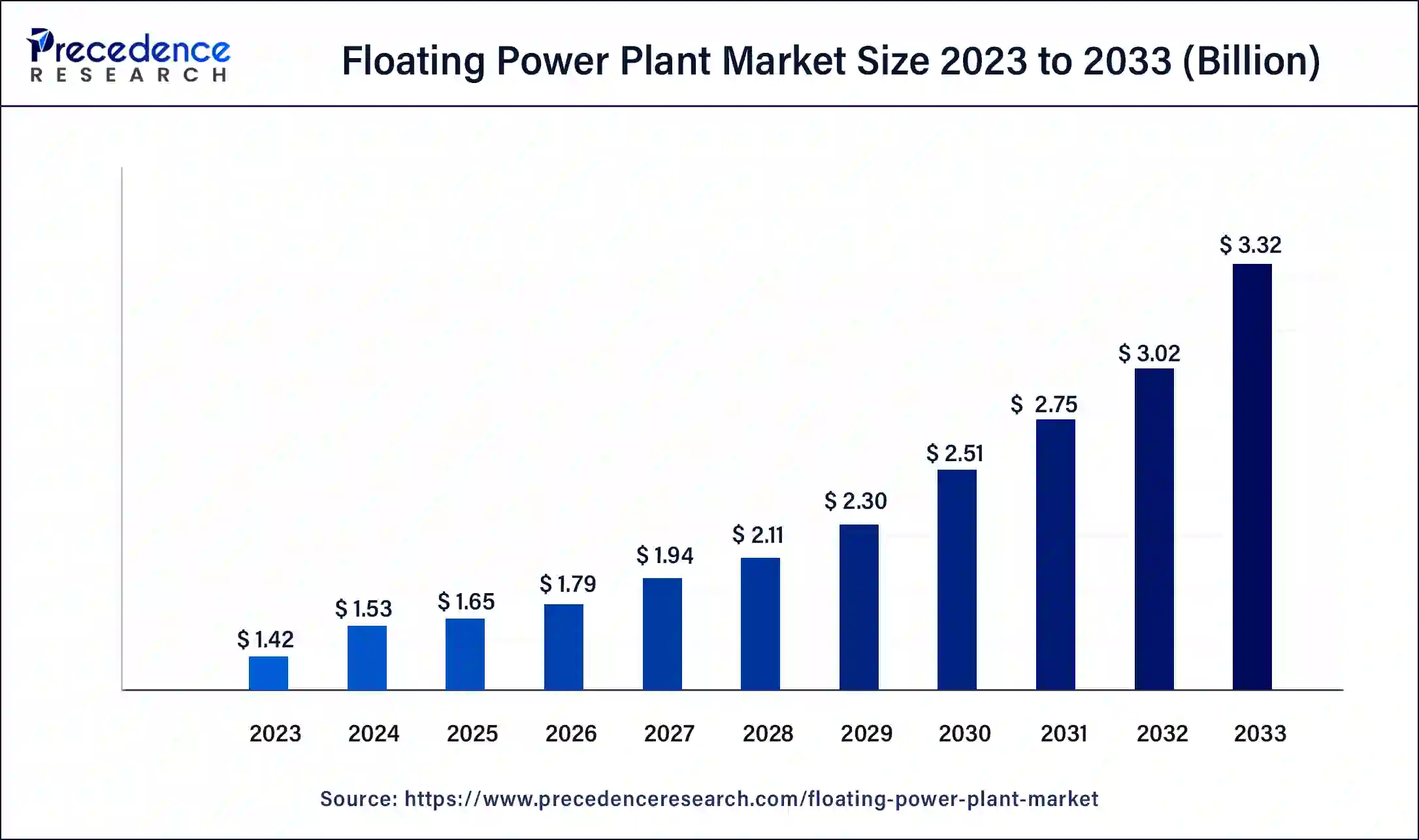
The Asia Pacific floating power plant market size was estimated at USD 547.93 million in 2023 and is predicted to be worth around USD 1,172.58 million by 2033, at a CAGR of 8.02% from 2024 to 2033.
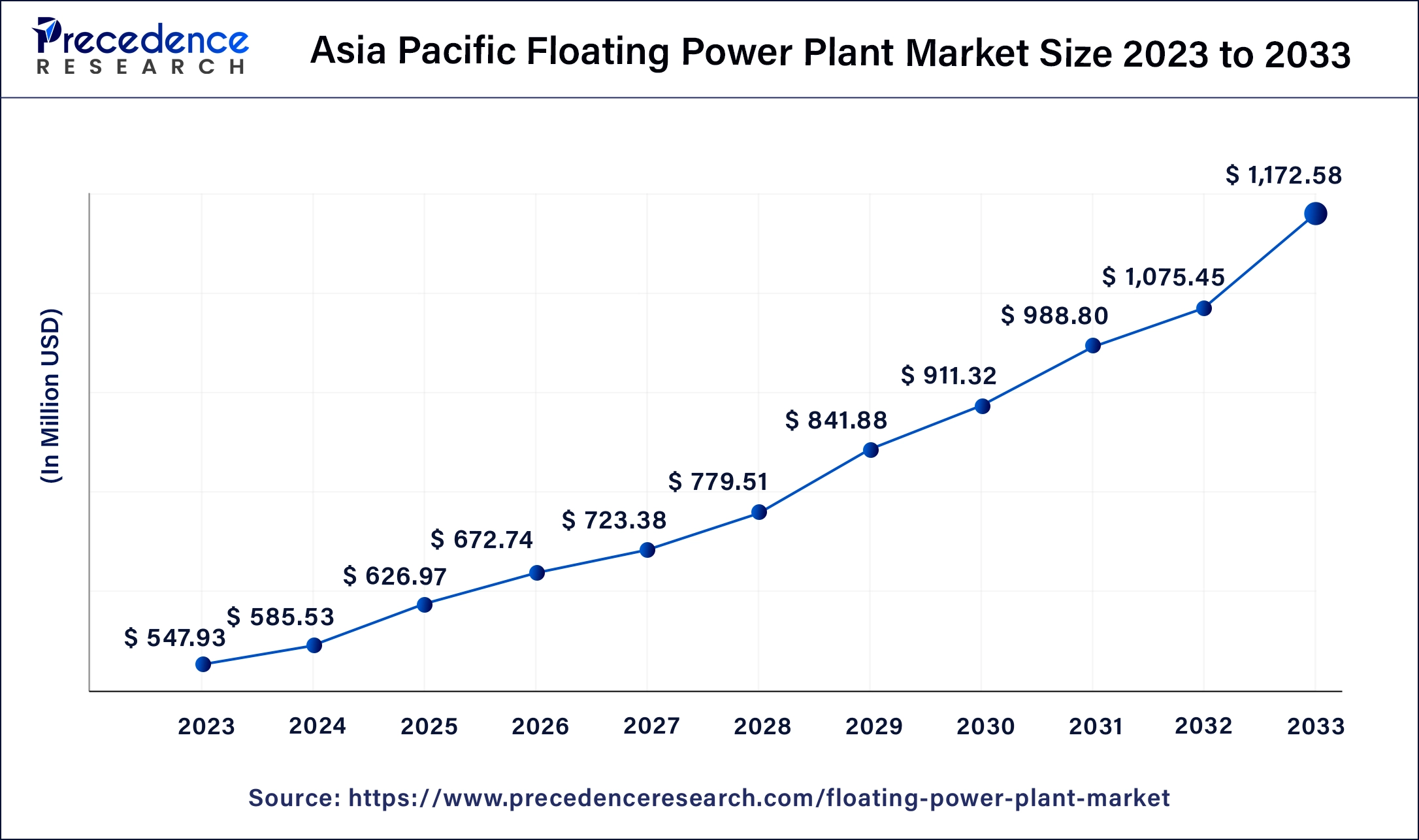
Asia Pacific dominated the floating power plant market in 2023. Increasing adoption of renewable sources for energy generation and lack of power infrastructure helps the growth of the market in the Asia Pacific region. India and China are the leading countries for the growth of the market. In India, the Rihand Dam Floating Power Plant is a remarkable renewable energy project located in Uttar Pradesh on the Rihand reservoir.
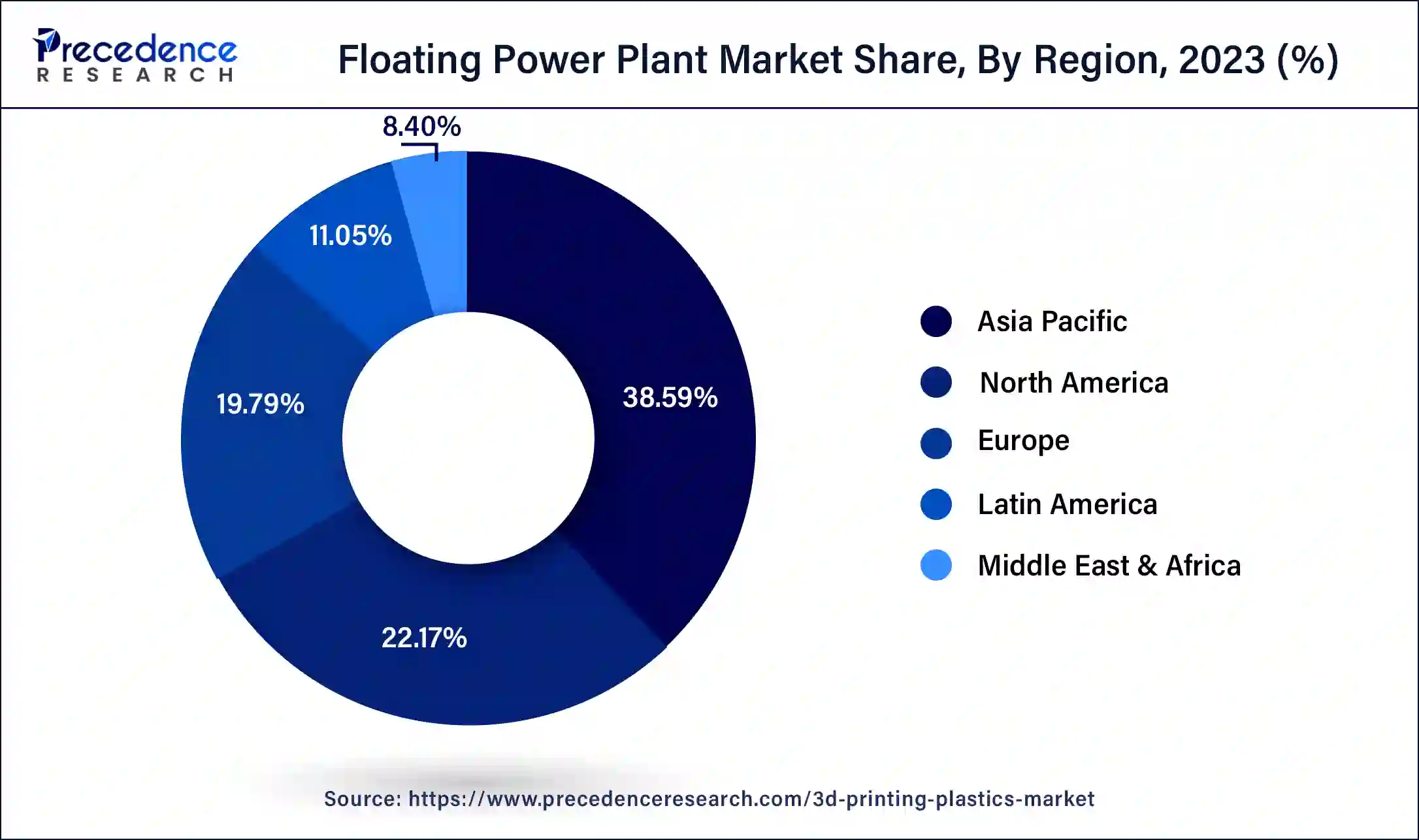
Europe held the second-largest share of the floating power plant market in 2023. Increasing government investments, lack of power infrastructure, and demand for low-power energy led to the growth of the floating power plant market in the European region.
The floating power plant is a combination of marine technology and power generation, and it offers flexible and decentralized power generation. The floating power plant market is gaining momentum as a viable and sustainable solution for generating electricity. These floating power plants are available in remote locations where a traditional power plant may be problematic. These are surrounded by water that may be used for active cooling or passive cooling. These are easily transported for decommissioning, refurbishment, refueling, and relocation.
The floating power plants are earthquake-resistant, and almost no concrete or land is used. The floating power plants have many advantages, including a natural cooling effect, which improves efficiency and energy yield. These factors help to the growth of the market.
| Report Coverage | Details |
| Market Size in 2023 | USD 1.42 Billion |
| Market Size in 2024 | USD 1.53 Billion |
| Market Size by 2033 | USD 3.32 Billion |
| Market Growth Rate from 2024 to 2033 | CAGR of 8.98% |
| Largest Market | Asia Pacific |
| Base Year | 2023 |
| Forecast Period | 2024 to 2033 |
| Segments Covered | Power Source Type, Power Rating Type, and Regions |
| Regions Covered | North America, Europe, Asia-Pacific, Latin America, and Middle East & Africa |
Increasing electricity demand
For sustainable power generation, floating power plants are highly used. The network of photovoltaics/ photovoltaics or floating solar panels is mounted on a structure that is made to float on the surface of a water body, which may be a pond, irrigation canal, lake, or reservoir. Generally, floating power plants have a floating system, a mooring structure, or a pontoon to prevent panels from moving freely in the water. This floating power plant system generates electricity by using thermal energy and the underwater cable to transfer the generated power or electricity to the substation.
This type of floating power plant is gaining traction quickly because of its potential for efficiency and higher energy compared to traditional land-based power plant systems. A floating power plant may be helpful in fighting climate change. It can generate more capacity than land-based power plants. These factors help to the growth of the floating power plant market.
Disadvantages of the floating power plant
The disadvantages of floating power plants include some negative impacts, such as ecosystem disruption. Large structures of the floating power plant in the water bodies may affect the aquatic ecosystem. The panel's shading may affect the aquatic plant's photosynthesis, which may have a negative effect on the aquatic life and water quality. Compared to land-based power plants, floating power plants are more expensive. The installation and material costs of the floating power plant are higher than those of the traditional ones. These factors can restrict the growth of the floating power plant market.
Rising innovation in floating technology
Increasing awareness and great potential for photovoltaic (PV) leads to rising innovation in floating technology. There is scope for the innovative search for flexible and sustainable energy sources from floating power plants. An improved range of energy efficiency can be obtained by the floating power plant. This floating power plant has a natural cooling effect from water, which improves energy efficiency and leads to a higher generation of energy than the traditional method. Minimum environmental impact and space utilization can be achieved with the help of a floating power plant. These opportunities help to the growth of the floating power plant market.
The non-renewable segment dominated the floating power plant market in 2023. Non-renewable power source types are highly used for floating power plants, including nuclear energy, thermal energy, liquified natural gas, gas turbines, IC (internal combustion) engines, diesel, etc. Nuclear energy is used in the floating power plant of the floating nuclear power plant type. Uranium fuel is highly used in nuclear reactors at the floating nuclear power plant. Floating power plants are helpful for converting mechanical energy or thermal energy into electrical energy by rotating turbines using energy sources such as nuclear power or natural gas, coal, oil, water, etc., and generating electricity by using a power generator that is connected to the turbines. IC engines-based floating power plants are highly used in the industry. Diesel engines are used in floating power plants to convert mechanical energy into electrical energy and have reliability, efficiency, and high energy density. Diesel fuel has various applications to provide electricity, such as primary power generation and backup power generation. These factors help the growth of the non-renewable power source type segment and contribute to the floating power plant market's growth.
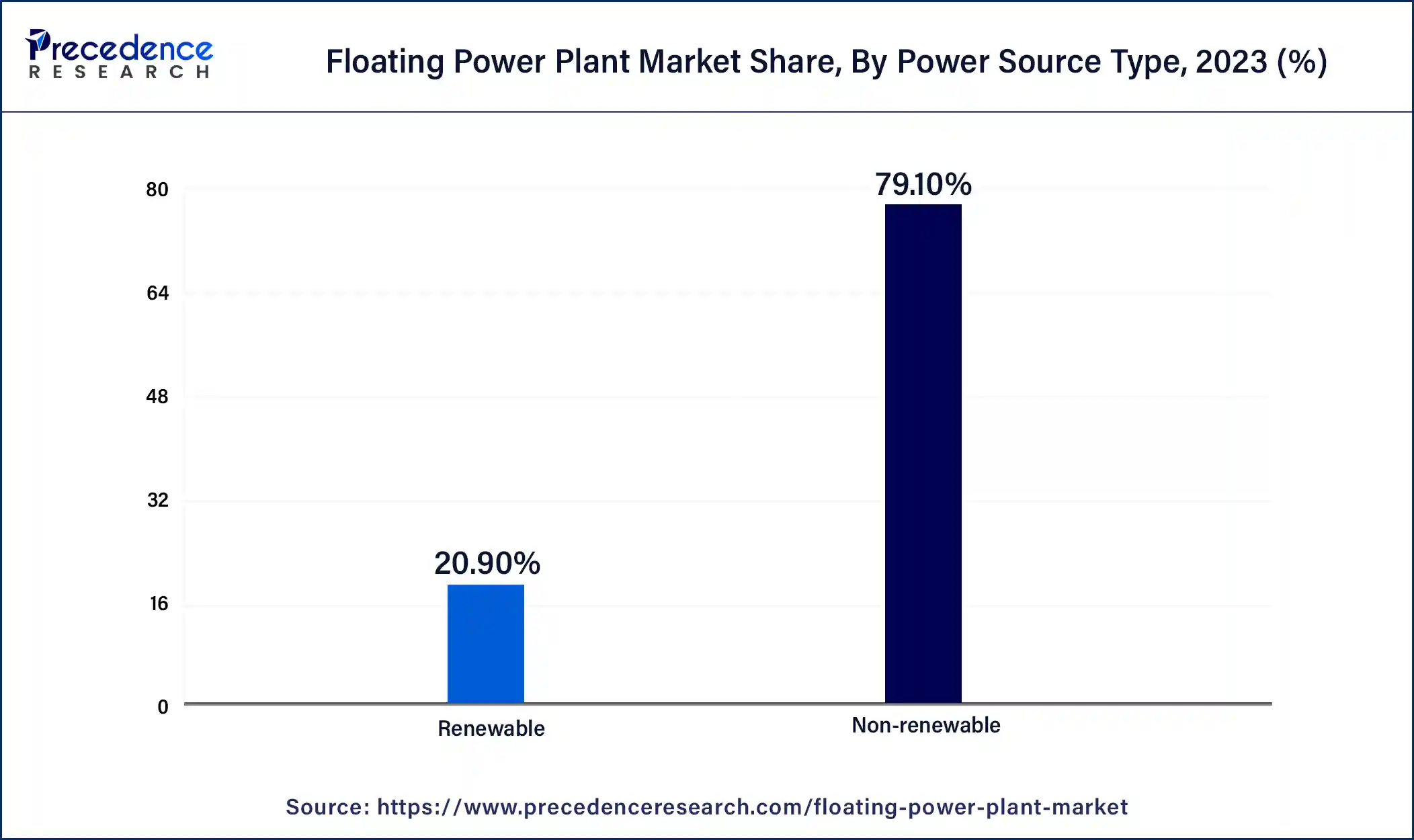
The renewable segment is anticipated to grow at a remarkable CAGR of 8.76% between 2024 and 2033. Renewable power source types are used for floating power plants, including wind, solar, bioenergy, ocean, hydropower, and geothermal energy. A clean source of renewable power is solar energy. It has various benefits compared to traditional sources of power. This type of floating power plant uses solar energy, there is no requirement for raw materials, and also there are fewer operational costs. Renewable floating power plants are used to generate clean energy using natural resources like wind or the sun.
The sun’s radiation is used in the floating power plant as a renewable power source to generate electricity. In wind farms, abundant wind resources are required to generate electricity. In the hydroelectric power plant, the potential energy of water is stored in dams to generate electrical energy. In marine power plants, the force of the sea is used to generate energy. These advantages of renewable power sources for energy generation have led to the growth of the renewable power source type segment and contributed to the growth of the floating power plant market.
Global Floating Power Plant Market Revenue, By Power Source Type, 2021-2023 (USD Million)
| Power Source Type | 2021 | 2022 | 2023 |
| Renewable | 258.84 | 276.88 | 296.73 |
| Non-renewable | 974.64 | 1,045.34 | 1,123.27 |
The high-power segment dominated the floating power plant market in 2023. In the high-power rating type, it includes greater than 100 MW power. The floating power plant reduces the water’s evaporation rate, and it also helps to maintain ambient temperature by improving electricity generation and efficiency. A 100MW capacity floating power plant may generate enough electricity to provide power to nearly 100000 homes for a day. These factors help the growth of the high-power rating type segment and contribute to the market's growth.
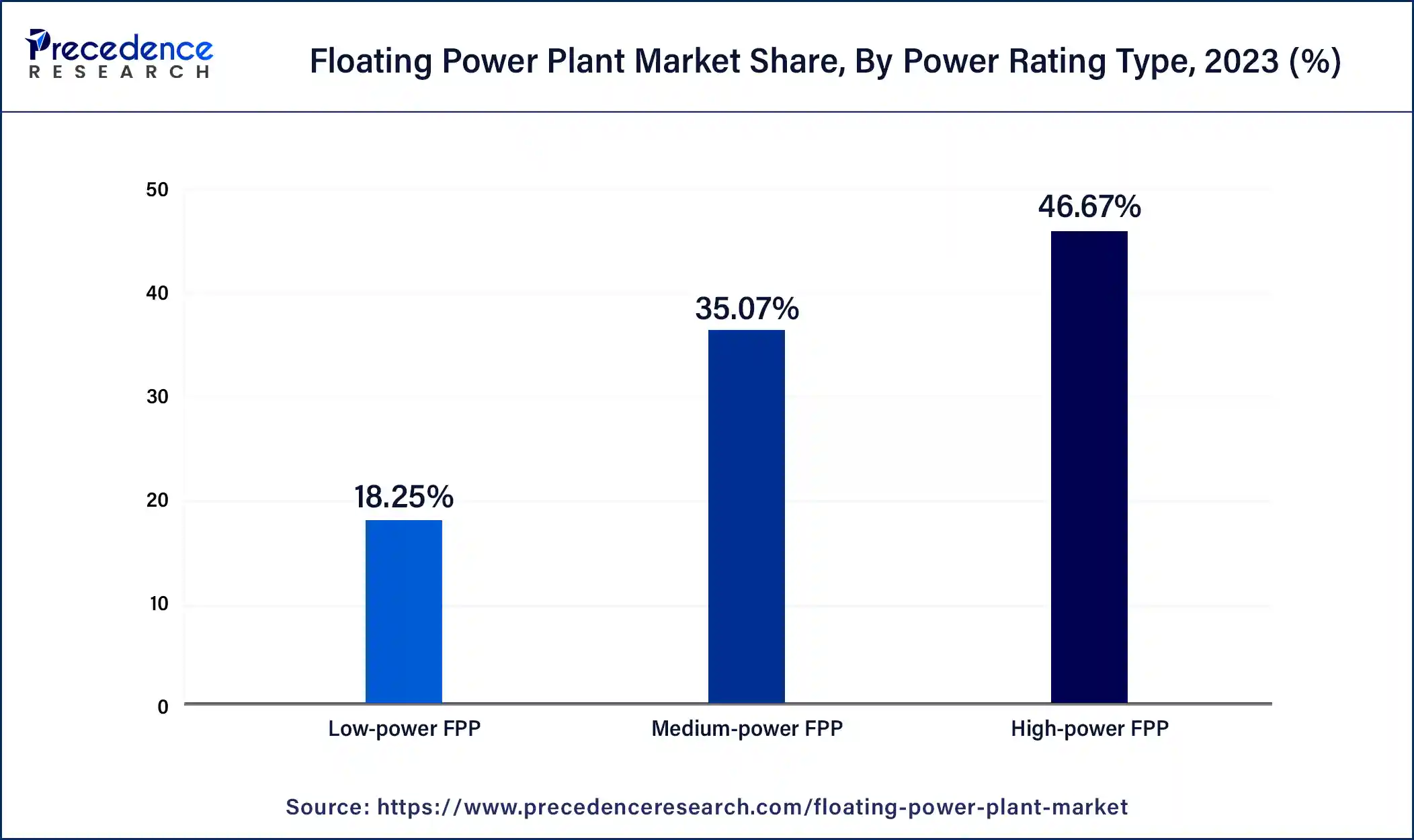
The medium-power segment is the fastest-growing during the forecast period. In medium-power floating power plants, power is 20MW to 100MW. It is used to prevent the evaporation of water and water cools. These help the growth of the medium-power power rating type segment and contribute to the growth of the floating power plant market.
Global Floating Power Plant Market Revenue, By Power Rating Type, 2021-2023 (USD Million)
| Power Rating Type | 2021 | 2022 | 2023 |
| Low-power FPP | 225.12 | 241.35 | 259.22 |
| Medium-power FPP | 431.35 | 463.06 | 498.01 |
| High-power FPP | 577.00 | 617.82 | 662.77 |
Segments Covered in the Report
By Power Source Type
By Power Rating Type
By Geography
For inquiries regarding discounts, bulk purchases, or customization requests, please contact us at sales@precedenceresearch.com
No cookie-cutter, only authentic analysis – take the 1st step to become a Precedence Research client
January 2025
December 2024
September 2024
September 2024